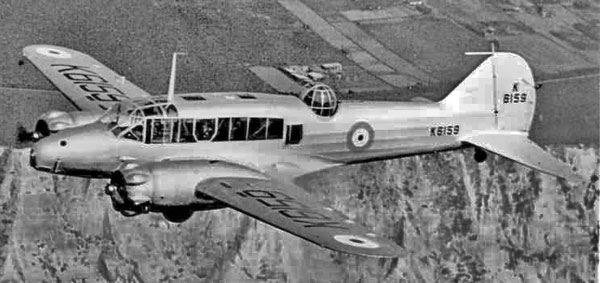
Very little is known about the events that surround this flight. What is known is that on 7th August 1941 the crew of this No.20 Operational Training Unit aeroplane were detailed to undertake a training flight and set out from Lossiemouth. In the course of the flight the aeroplane unfortunately suffered from having the starboard engine fail in the air, control must have eventually been lost and it crashed onto high ground at around 12.00hrs on Little Garvoun; one of the minor peaks to the north of Glen Avon. Sadly all on board were killed including a high ranking officer who is believed to have been a passenger.
I visited this site on the closest day to the seventieth anniversary as could be arranged as it happened to be at the same time. In 2011 the remaining more intact engine at the crash site is the starboard engine, this would suggest that the aircraft had crashed with it's port wing down with the port engine still under power at the time of the crash which left it badly damaged. Being many miles from the nearest road there seems to have been little effort made to recover or even bury the wreckage. A network of deer stalking tracks in the area allow for better access now though any walk to the site is still a long day. The Glenavon Estate would appreciate contact from anyone intending to visit the site between August and October during the deer stalking season.
Pilot - F/O Patrick Braund Doorly RAF (91199), aged 27, of Penarth. Buried Penarth Churchyard, Glamorganshire.
Navigation Instructor – P/O Alexander George Gill RAFVR (89587), Buried Elgin New Cemetery, Morayshire. (H/South Div/36).
Observer - P/O Harold Ernest Waite RAFVR (102551), aged 24. Buried Greenford Park Cemetery, Middlesex.
Air Gunner - Sgt Thomas Cyril Gallant RAFVR (798515), aged 22, of Stephenville, Newfoundland. Buried Lossiemouth Burial Ground, Morayshire.(grave 1083).
Wireless Operator / Air Gunner - F/Sgt George William Hemsley RAF (628516), aged 21, of Blyth. Buried Cowpen Cemetery, Blyth, Northumberland.
Wireless Operator / Air Gunner - Sgt William Henry Petratos RAFVR (1102286), aged 21, of Cardiff. Buried Cardiff Cathays Cemetery, Glamorganshire.
Passenger - AC2 John Edgecombe RAFVR (1030367). Buried Lossiemouth Burial Ground, Morayshire (1082).
Passenger - G/C John Edward Tennant DSO MC RAFVR (74576), aged 51, of Urquhart. Buried Lochhill, Innes House Private Burial Ground, Urquhart, Elgin, Morayshire.

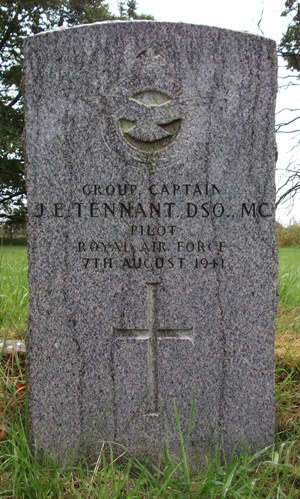
John Edward Tennant was born on 12th October 1890 in Colgrain, Scotland. He was a veteran of the First World War initially serving with the Scots Guards before being seconded to the Royal Flying Corps and serving in the Middle East. As Captain in the RFC he was awarded the Military Cross for gallantry and distinguished service in the field, in connection with the engagement at Solium, Egypt between 14th/17th March 1916. The citation for his M.C. was Gazetted on 28th March 1916 and reads..
"During the night he bombed the sheds of an enemy aerodrome, descending to 30 feet to do so. He shut off his engine in order to avoid giving warning, although there was risk of not being able to start it again. His machine was much damaged by the explosion of his own bombs at so low a height. On his return he requested permission to take another machine and repeat the operation."
He was later Mentioned in Despatches a number of times, firstly on 30th April 1916 (Gazetted on 15th June 1916), secondly on 17th November 1917 (Gazetted on 13th March 1918) and again in April 1918. During this time he survived being shot down in his DH4 aircraft. While holding the rank of Major (and Temporary Lt.Col.) he was awarded the Distinguished Service Order "for gallantry and distinguished service in Mesopotamia", Gazetted 3rd August 1918 but no citation has yet been found for his DSO. Lieut.Col. Tennant DSO MC (Capt, Brev.Major, Scots Guards) resigned his commission on 6th September 1919, he later wrote the book "In The Clouds Above Baghdad" following his experiences between 1916 and 1918.

What he did in the years after the First World War is not known, however in 1933 he was the Chairman of the Scremerston Colliery, Berwick on Tweed. When the Second World War broke out he offered his services and was granted a commission in the RAF as P/O on probation on 26th September 1939, this was later confirmed as P/O on 26th September 1940. He was however granted a war substantive rank of Squadron Leader on 30th December 1939. At the time of his death in August 1941 he was the first Commandant of the Air Cadets in Scotland (the then newly-formed Air Training Corps). At the time of his death his rank had risen to Group Captain though there is no reference to this in the London Gazette suggesting that this was of a temporary nature. The RAF casualty file "AIR81-8132" has a note that he was also in a position with H.Q. Intelligence Corp, Scotland from March 1941.
His son Sir Iain Mark Tennant KT was Lord Lieutenant of Morayshire from 1963-94; Crown Estate Commissioner from 1970-90; Lord High Commissioner to the General Assembly, Church of Scotland from 1988-89. He was present when the memorial was erected at the crash site but has since died.
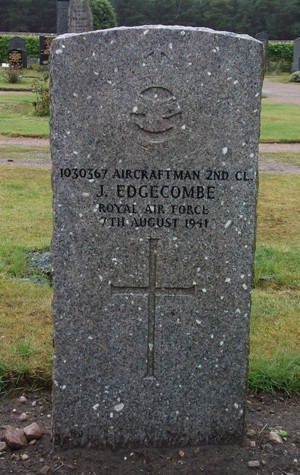
John Edgecombe's grave at Lossiemouth Cemetery.
Patrick Doorly was initially in the Auxiliary Air Force before War was declared and received a commission to the rank of Acting P/O on probation on 8th June 1939 while serving with 614 (County of Glamorgan) Squadron. He was graded as P/O on 2nd June 1940 but would appear to have being in a ground unit in August 1940 when he transferred to the Balloon Branch. The was later cancelled a few months later the same year probably after he was selected for pilot training. He rose to F/O (war subs) on 11th April 1941.
Harold Waite received a commission to the rank of P/O on probation on 15th June 1941.
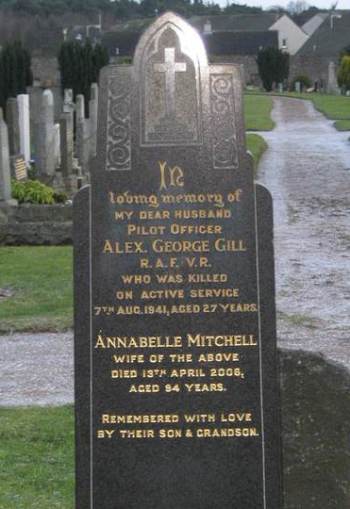
Alexander Gill had completed a Tour of thirty operational flights with Bomber Command and had been posted to 20 OTU to instruct but the Squadron he had served with is not yet known. He received a commission to the rank of P/O on probation on 17th December 1940 (back dated to 11th December 1940).
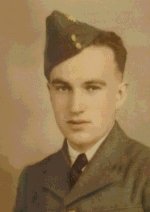
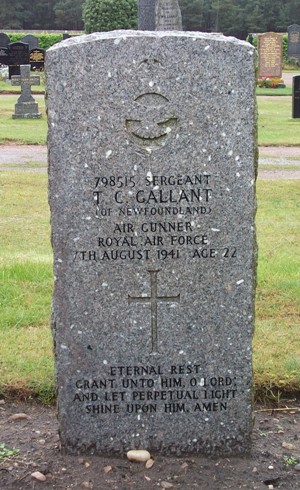
Thomas Gallant and his grave at Lossiemouth Cemetery.
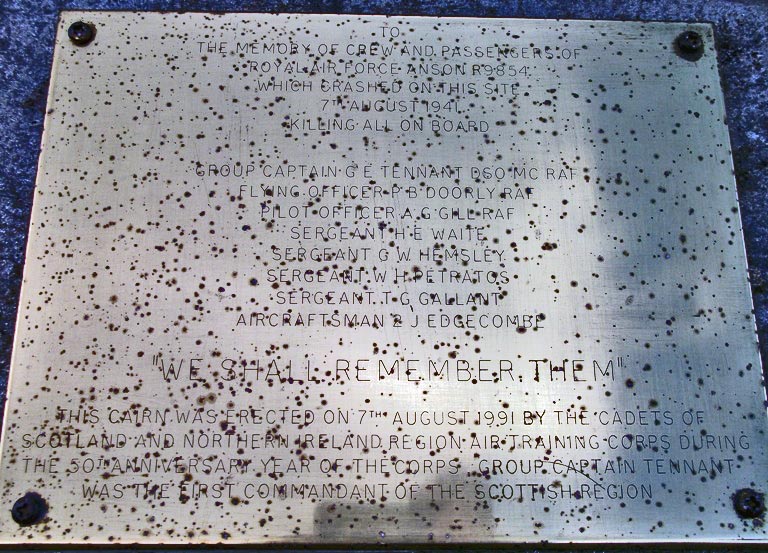
At that time of my visit in 2011 the memorial plaque at the site was difficult to photograph because of the shininess of it. The photograph above has been played with on Photoshop to bring out the lettering. The plaque contains two errors; the aircraft serial number of "R9854" is incorrect and should read "R9584" and the plaque shows "T.G.Gallant" not "T.C.Gallant". The plaque has since been replaced.

The large scar created as a result of the accident.
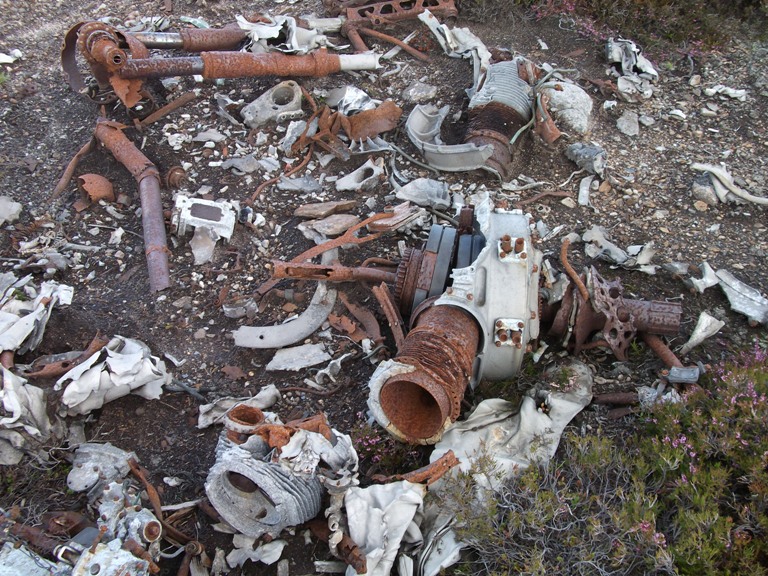
The remains of the port engine and an undercarriage leg.
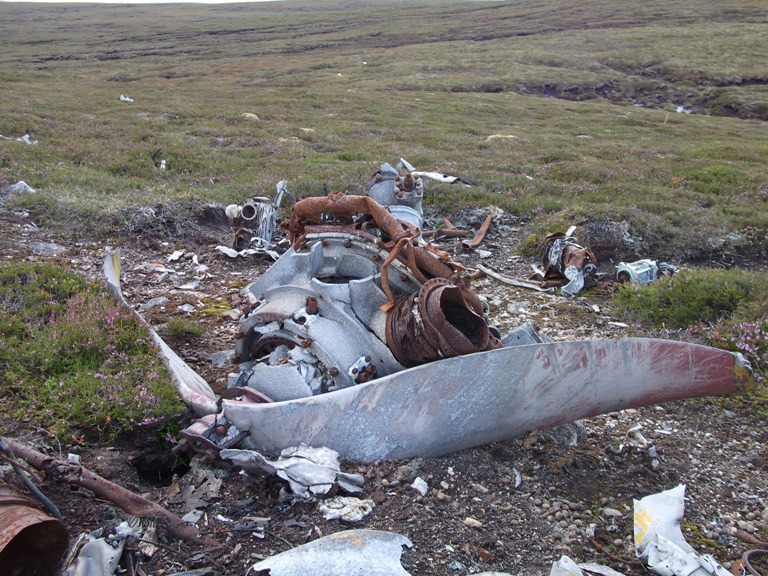
The more complete starboard engine with reasonably un-bent propeller suggesting that this engine was not turning at the time of the crash.

A glazed part of the Armstrong Whitworth gun turret in reasonably good condition.
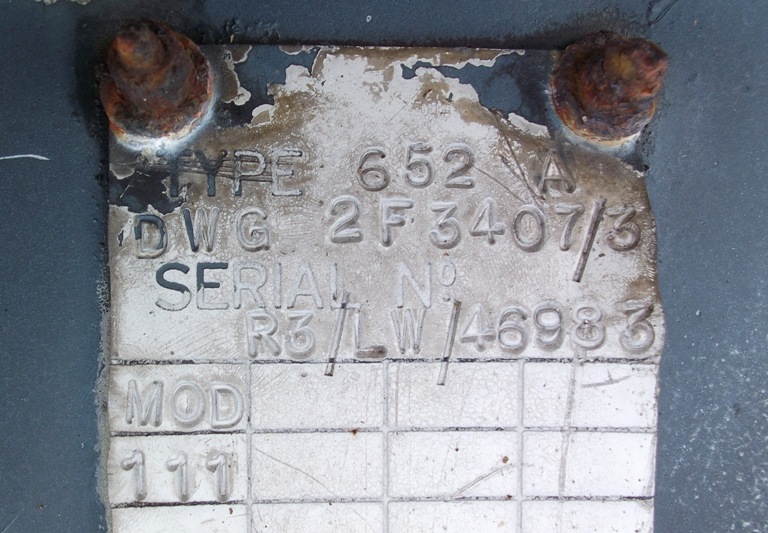
The site appears well picked over and many of the plates which the aircraft would have carried are now missing although a modification plate was found on a piece of wing section when I visited the site in August 2011. The "Type 652 A" refers to the Avro 652-A which was the Avro design number for Anson; a superb identification piece. A lot of pieces of the aircraft carry the "R3" inspection numbers which would usually mean the aircraft was built by Avro.

Myself with the remains of the more intact starboard engine.